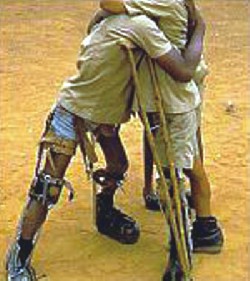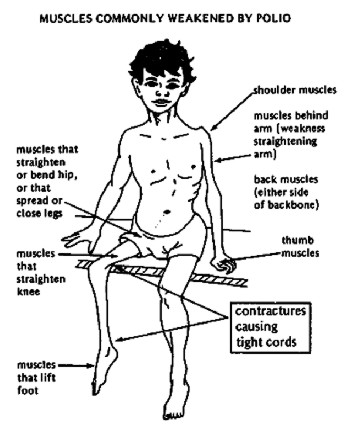|
Health
Polio Making a Comeback
Poliomyelitis is an "inflammation of the gray matter of the spinal cord. Polio is caused by a virus which results in an acute infection.
Where is polio found?
Before the availability of polio immunisation, polio was common worldwide. However, with strong immunisation programs and efforts to rid the world of polio, circulation of polio viruses is limited to a decreasing number of countries. The greatest risk is now in the Indian subcontinent and, to a lesser extent, in West and Central Africa.
How do people get polio?
The polio virus lives in the throat and intestinal tract of infected persons. The virus enters the body through the mouth, usually from hands contaminated with the stool of an infected person. Objects, such as eating utensils, can also spread the virus. Food and water are not thought to play a major role in the spread of polio.
What are the signs and symptoms of polio?
Polio is a viral illness that, in about 95% of cases, actually produces no symptoms at all (called asymptomatic polio). In the 4% to 8% of cases in which there are symptoms (called symptomatic polio), the illness appears in three forms:
- a mild form called abortive polio (most people with this form of polio may not even suspect they have it because their sickness is limited to mild flu-like symptoms such as mild upper respiratory infection, diarrhoea, fever, sore throat, and a general feeling of being ill)
- a more serious form associated with aseptic meningitis called nonparalytic polio (1% to 5% show neurological symptoms such as sensitivity to light and neck stiffness)
- a severe, debilitating form called paralytic polio (this occurs in 0.1% to 2% of cases)
People who have abortive polio or nonparalytic polio usually make a full recovery. However, paralytic polio, as its name implies, causes muscle paralysis - and can even result in death. In paralytic polio, the virus leaves the intestinal tract and enters the bloodstream, attacking the nerves (in abortive or asymptomatic polio, the virus usually just stays in the intestinal tract). The virus may affect the nerves governing the muscles in the limbs and the muscles necessary for breathing, causing respiratory difficulty and paralysis of the arms and legs.
 How soon after exposure do symptoms appear? How soon after exposure do symptoms appear?
Symptoms usually start 7 to 14 days after exposure to the virus. Infected persons are most contagious from a few days before to a few days after the start of symptoms. However, persons with polio can spread the infection for as long as the virus is in their throat or stool. The virus can be found in the throat for about 1 week after infection and in the stool for 6 weeks or longer.
How is polio diagnosed?
Polio is diagnosed by a blood test or culture.
Who is at risk for polio?
Polio is most common in infants and young children, but complications occur most often in older persons.
What complications can result from polio?
Complications include paralysis, most commonly of the legs. Paralysis of the muscles that control breathing and swallowing can be fatal.
In very rare cases, the oral vaccine used to prevent polio can cause polio paralysis in persons who are vaccinated (1 in every 8.1 million doses) and in people who are close contacts of a vaccinated person (1 in every 5 million doses).
How can polio be treated?
In the height of the polio epidemic, the standard treatment involved placing a patient with paralysis of the breathing muscles in an "iron lung" - a large machine that actually pushed and pulled the chest muscles to make them work. The damaged limbs were often kept immobilized because of the confinement of the iron lung. In countries where polio is still a concern, ventilators and some iron lungs are still used.
Historically, home treatment for paralytic polio and abortive polio with neurological symptoms wasn't sufficient. However, asymptomatic and mild cases of abortive polio with no neurological symptoms might have been treated like the flu, with plenty of fluids and bed rest.
How can polio be prevented?
Two types of polio vaccine are available: oral polio vaccine (OPV) and inactivated polio vaccine (IPV).
 OPV is made with a live but weakened virus. OPV protects vaccinated persons directly. OPV also protects other susceptible persons who are indirectly "vaccinated" as the vaccine virus spreads in the community. Because of wide use of OPV, no cases of paralytic polio caused by naturally circulating poliovirus have been reported in the United States since 1979. OPV is made with a live but weakened virus. OPV protects vaccinated persons directly. OPV also protects other susceptible persons who are indirectly "vaccinated" as the vaccine virus spreads in the community. Because of wide use of OPV, no cases of paralytic polio caused by naturally circulating poliovirus have been reported in the United States since 1979.
IPV is given by injection. It protects vaccinated persons as well as OPV, but it is not believed to be as effective as OPV in preventing the spread of poliovirus among non-vaccinated persons. However, IPV is not known to cause polio disease.
As of January 1997, the recommended schedule for polio vaccination for children was two doses of IPV at 2 and 4 months of age, followed by two doses of OPV at 12-18 months and 4-6 years. This schedule is expected to reduce the small number of polio cases caused by the oral vaccine.
Schedules containing all OPV or all IPV can still be used, too. IPV can be given at 2, 4, and 12-18 months, and 4-6 years. OPV can be given at 2, 4, and 6-18 months, and 4-6 years. Parents and doctors can choose among the three schedules.
Booster doses of polio vaccine are also recommended for persons travelling to areas of the world where polio is still a problem.
As is the case with all immunisations, there are important exceptions and special circumstances. Health-care providers should have the most current information on recommendations about polio vaccination.
The Future of Polio
The World Health Organization (WHO) is working toward eradicating polio throughout the world. Significant strides have already been made. In 1988, 355,000 cases of polio in 125 countries were reported. By the end of 2004, there were just 1,255 cases.
Bangladesh will vaccinate nearly 18 million children against polio beginning next month after detecting the first case of the crippling disease in nearly six years. Children under the age of five will be vaccinated during three nationwide immunization days - on April 16, May 13 and June 11.
Bangladesh carried out extensive vaccination programs from 1995-2004, with the last polio case reported in August 2000, according to the government and the WHO. But the country's efforts to be declared polio-free were thwarted with the recently identified case of a 9-year-old girl who became paralysed by the disease.
Laboratory tests earlier this month confirmed the disease in the girl in eastern Chandpur district.
A local health official said the girl developed signs of paralysis in January after coming in contact with a family who had recently visited India's Uttar Pradesh state.
She was infected despite taking 12 doses of polio vaccine during previous vaccination drives, said the official.
The planned nationwide immunization drive is meant to prevent the virus spreading to neighbouring areas, officials said.
Source: The Internet
Copyright
(R) thedailystar.net 2006 |
